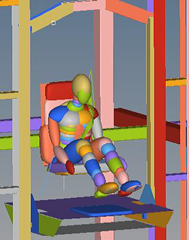Systems of Systems & Integration
Annual PlanMultilevel Vehicle Design: Fuel Economy, Mobility, and Safety Considerations
Project Summary
Principal Investigators
- Panos Papalambros, University of Michigan
- Michael Kokkolaras, University of Michigan
Faculty
- Greg Hulbert, Matt Reed, Hosam Fathy, Zheng-Dong Ma, Zoran Filipi, Heath Hofmann, University of Michigan
- Zissimos Mourelatos, Oakland University
Students
- Subroto Gunawan (Post-doc), Miles Chan, Jeongwoo Han, Kwang Jae Lee, Michael Alexander, Steven Hoffenson, “Max” Yi Ren, University of Michigan
Government
- Sudhakar Arepally, Matt Castanier, Paul Decker, David Gorsich, Jo Hartingh, Michael Megiveron, U.S. Army GVSC
Industry
- Tao Jiang, Terry Wagner, Ford; Bashar Abdul Nour, Ramprasad Krishnamachari, GDLS
- Rohit Paranjpe, Madhu Raghavan, Michael Alexander, GM R&D
- Paul Weal, Michael Sasena, Diane Peters, Nick Tzannetakis, LMS International
Work began in 2006 and was completed in 2012.

Army vehicles are designed for multiple objectives including performance, reliability, maintainability, and survivability while considering a wide range of operating environments. Design requirements for increased energy efficiency, including alternative powertrain configurations, must be carefully balanced with those for survivability. Initial research has led to robust, novel decomposition-based methodologies for hierarchical, multilevel vehicle design optimization. These methodologies were integrated with reliability and design under uncertainty considerations. A significant enhancement of these results can be achieved if we also account for the actual physical geometry of the different designs, i.e., three-dimensional representation of the components comprising the vehicle and their impact on various attributes. The first objective of this research integrated geometry representation into optimal design methodologies in order to account for geometry-related attributes and quantify interactions with functional vehicle design requirements. This objective required the development of techniques for reduced representation of infinite-dimensional quantities (such as vector-valued coupling variables) and algorithms for making design decisions with respect to quantitative design objectives such as maintenance. The second objective extended the multilevel design framework to predict the impact of unexpected events (e.g., blasts or accidents) to vehicle designs and assess effects on soldier safety. In particular, the relation between vehicle mass, shape and safety was investigated and modeled.
Publications:
- M. J. Alexander, J. T. Allison, P. Y. Papalambros, “Reduced Representations of Vector-Valued Coupling Variables in Decomposition-Based Design Optimization”, 8th World Congress on Structural and Multidisciplinary Optimization, Lisbon, Portugal, June 1-5, 2009.
- S. Hoffenson, M. Kokkolaras, P. Y. Papalambros, M. Reed, “An Optimization Approach to Occupant Safety and Fuel Economy in Vehicle Design”, 8th World Congress on Structural and Multidisciplinary Optimization, Lisbon, Portugal, June 1-5, 2009.
- S. Hoffenson, M. Kokkolaras, P. Y. Papalambros, M. Reed, “Automotive Body Design Optimization for Safety and Fuel Economy”, 8th World Congress on Structural and Multidisciplinary Optimization, Lisbon, Portugal, June 1-5, 2009.
- M. J. Alexander, P. Y. Papalambros, “An Accuracy Assessment Method for Two-Dimensional Functional Data in Simulation-Based Design”, 13th AIAA/ISSMO Multidisciplinary Analysis Optimization Conference, Fort Worth, TX, September 13-15, 2010.
- M. J. Alexander, J. T. Allison, P. Y. Papalambros, D. J. Gorsich, “Constraint Management of Reduced Representation Variables in Decomposition-based Design Optimization”, ASME International Design Engineering Technical Conferences, DETC2010-28788, Montreal, Quebec, Canada, August 15-18, 2010.
- M. J. Alexander, P. Y. Papalambros, “Enhancing the Design Process for New Vehicle Architectures”, MASS 2010 Research Symposium, University of Michigan, Ann Arbor, MI, 2010.
- M. J. Alexander, J. T. Allison, P. Y. Papalambros, D. J. Gorsich, “Constraint Management of Reduced Representation Variables in Decomposition-based Design Optimization”, ASME International Design Engineering Technical Conferences, DETC2010-28788, Montreal, Quebec, Canada, August 15-18, 2010.
- M. J. Alexander, P. Y. Papalambros, “Enhancing the Design Process for New Vehicle Architectures”, MASS 2010 Research Symposium, University of Michigan, Ann Arbor, MI, 2010.
- M. J. Alexander, J. T. Allison, P. Y. Papalambros, “Decomposition-based Design Optimization of Electric Vehicle Powertrains using Proper Orthogonal Decomposition”, International Journal of Powertrains, Vol. 1, No. 1, 72-92, 2011.
- M. J. Alexander, J. T. Allison, P. Y. Papalambros, “Reduced Representations of Vector-Valued Coupling Variables in Decomposition-based Design Optimization”, Structural and Multidisciplinary Optimization, 44(3):379-391, 2011.
- S. Hoffenson, S. Arepally, M. Kokkolaras, P. Y. Papalambros, “Ground Vehicle Safety Optimization Considering Blastworthiness and the Risks of High Weight and Fuel Consumption”, 3rd Annual Ground Vehicle Systems Engineering and Technology Symposium (GVSETS), August 9-11, 2011. Best paper award.
- S. Hoffenson, “Safety Optimization Formulations, Standards, and Tradeoffs, and Their Impact on Automobile Design”, Design Frontiers Symposium, Ann Arbor, Michigan, May 19-20, 2011.
- S. Hoffenson, P. Y. Papalambros, “The Impact of Safety Standards and Policies on Optimal Automobile Design”, 18th International Conference on Engineering Design, Copenhagen, Denmark, August 15-18, 2011.
- S. Hoffenson, P. Y. Papalambros, M. Kokkolaras, S. Arepally, “Weight and Blastworthiness Design Considerations for Military Ground Vehicle Safety Optimization”, 9th World Congress on Structural and Multidisciplinary Optimization, Shizuoka, Japan, June 13-17, 2011.
- S. Hoffenson, B. D. Frischknecht, P. Y. Papalambros, “A market systems analysis of the U.S. Sport Utility Vehicle market considering frontal crash safety technology and policy”, Accident Analysis & Prevention, Volume 50, Pages 943–954, January 2013.
- S. Hoffenson, M. P. Reed, Y. Kaewbaidhoon, P. Y. Papalambros, “On the impact of the regulatory frontal crash test speed on optimal vehicle design and road traffic injuries”, International Journal of Vehicle Design, 63(1):39-60, 2013.
- S. Hoffenson, S. Arepally, P. Y. Papalambros, “A multi-objective optimization framework for assessing military ground vehicle design for safety”, Journal of Defense Modeling and Simulation: Applications, Methodology, Technology, vol. 11 no. 1 33-46, January 2014.
- S. Hoffenson, S. Arepally, M. Kokkolaras, P. Y. Papalambros, “Quantification of the design relationship between ground vehicle weight and occupant safety under blast loading”, International Journal of Vehicle Design, Vol. 61, No.1/2/3/4 pp. 204 - 218, 2013.

